'I am shocked': Patient assaults at SWFL hospitals a constant threat to health workers
- Oops!Something went wrong.Please try again later.
The 14-year-old patient’s hair-raising threat to an emergency room nurse at a Naples hospital sent staff running to the nurse’s aid.
“I’m going to slay you and I won’t even feel bad about it,” the teenage girl screamed. “I’m going to …. kill you bitch.”
Two nurses and a technician grabbed the teen’s flailing arms and legs she weaponized with her rage. The team at NCH North Hospital resorted to restraining the 95-pound patient. They sedated her, an industry practice when patients get out of control.
Moments earlier the teen had grabbed a nurse’s glasses, kicked her in the chest and neck, bit her in the arm.
The violent outburst in March 2022, which ended with two injured nurses and the teen’s arrest, is just one case of verbal and physical attacks that happen regularly at hospitals nationwide.
Two nurses are assaulted every hour, roughly 57 a day or 1,739 a month, according to an analysis of second quarter 2022 national data by the healthcare consulting firm, Press Ganey.
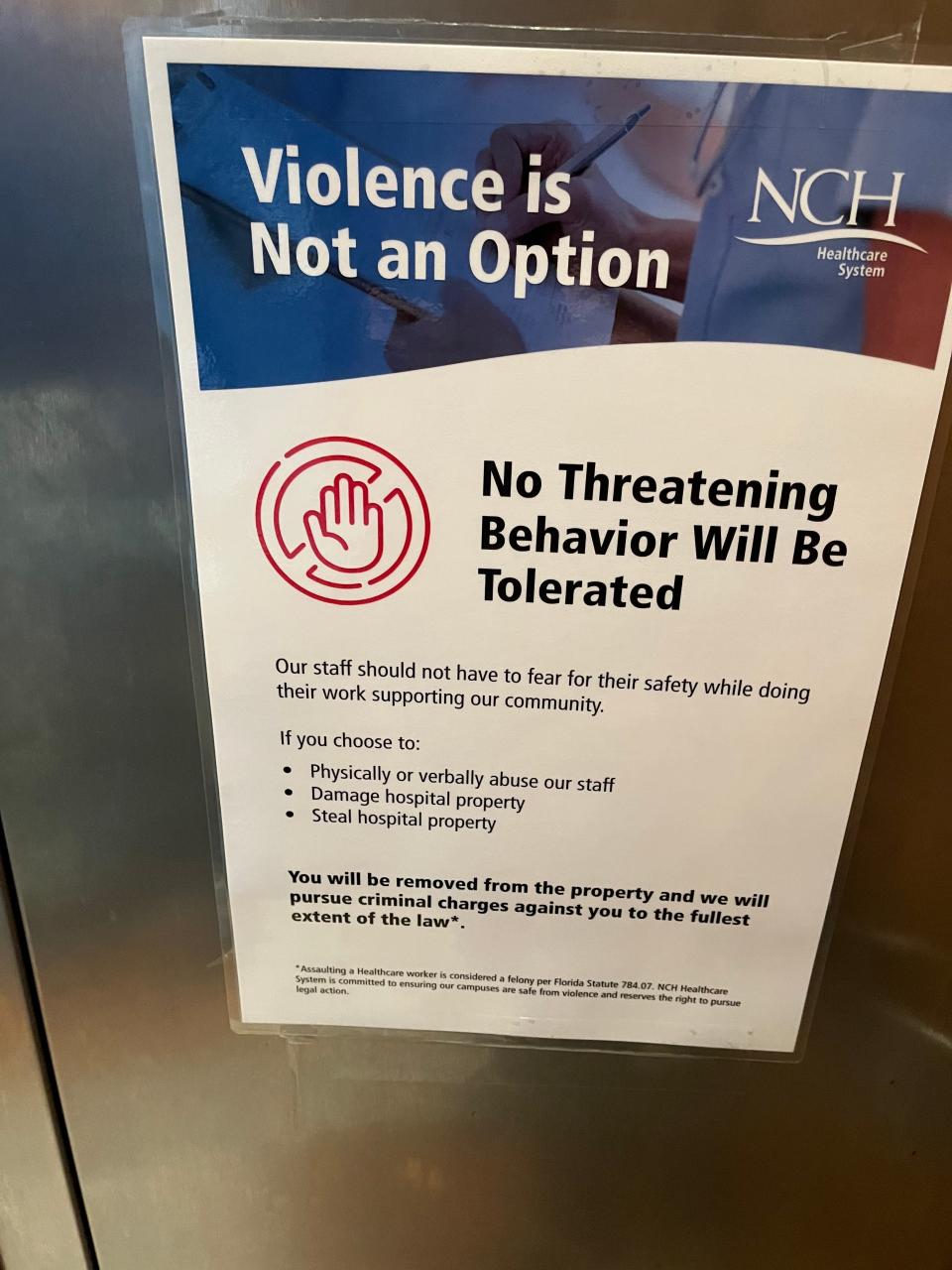
Nurses, physicians and support staff face staying in an increasingly volatile work environment or changing career paths, while hospital leaders grapple with improving safety and preventing worker shortages from worsening. All impacts patient care, experts say.
Thirty states have passed get-tough legislation against perpetrators, including Florida last year, according to the Emergency Nurses Association based in the Chicago area.
Two federal bills have been filed. Florida Sen. Marco Rubio proposes prison time for people who knowingly assault health care workers.
More: Healthgrades ranks six SWFL hospitals among top 100 in U.S.
The second bill would require a national standard to help prevent workplace violence for the health care industry.
“I am shocked at what I am hearing about and the type and level of violence,” Mary Mayhew, president and chief executive officer of the Florida Hospital Association, said. “No one should be afraid of coming to work.”
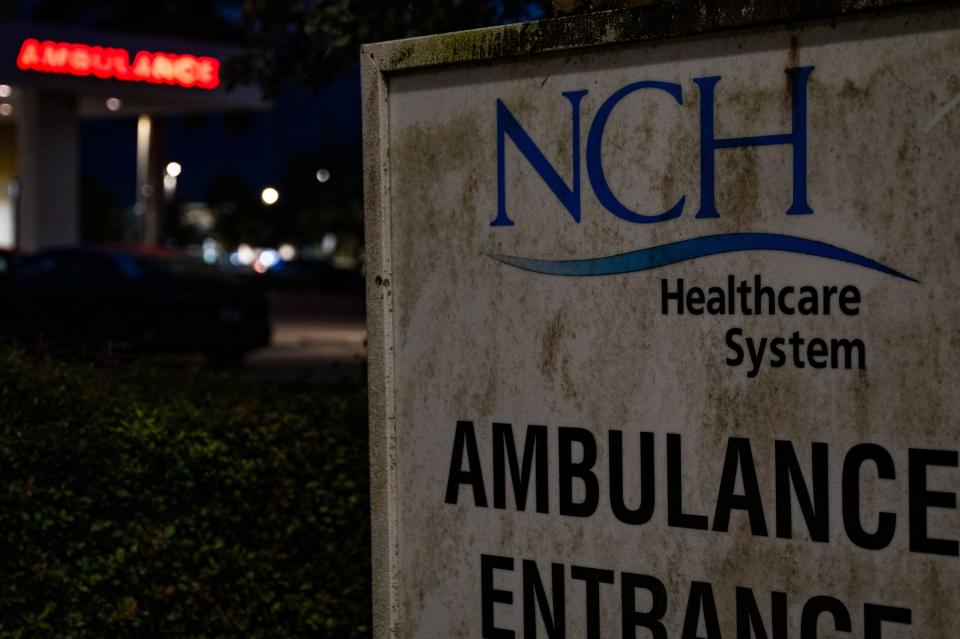
What are patients doing?
NCH declined to share internal incident data of aggressive patients but arrest reports show how employees are hit, kicked, spat on and may need medical attention after attacks.
On Aug. 31, 2023 at NCH North hospital, a 45-year-old male patient, Christopher Willingham, threw water on a male employee and lunged at him, according to the arrest report.
The employee grabbed the patient to stop from being hit and both went to the floor. The patient got a chokehold of the employee and kicked him until NCH security stepped in.
Earlier on Aug. 5 at NCH Northeast, a freestanding emergency room, 53-year-old Louis Sepesi came up from behind a nurse and violently pushed the nurse in the head causing injuries, according to the arrest report.
More: Naples man pushed ER nurse, flooded room and removed his clothes
The patient stripped naked and pulled a high-pressure water pipe from a wall. The nearby emergency room flooded and was temporarily closed. The patient threatened to kill deputies. A taser was used to get him in custody.
A high-profile arrest involved the wife of NCH’s top leader who kicked two nurses in the emergency room at NCH Baker Hospital on Oct 18.
Kristen Hiltz, 58, turned herself in to authorities when she was discharged six days later. The nurses said they intended to press charges.
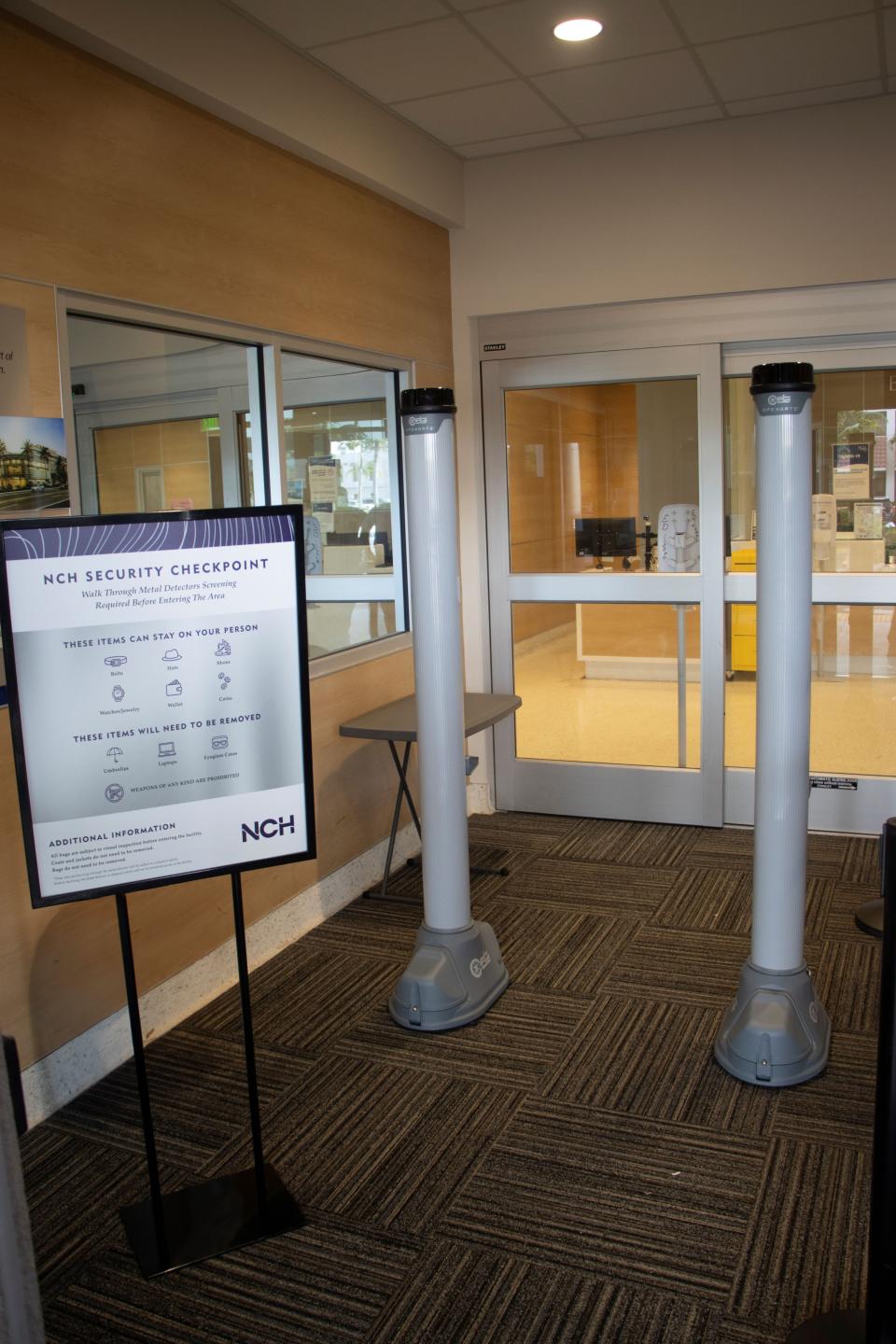
Paul Hiltz, NCH’s president and chief executive officer, issued a statement he was saddened by what happened and that any violence against NCH colleagues would not be tolerated.
“This patient incident was handled no differently than any other and I fully support the rights of our NCH healthcare team,” he said
Other Naples hospitals not spared
The private for-profit Physicians Regional Healthcare System in Naples isn’t immune to patients attacking employees.
On March 10 last year a technician at the system’s Pine Ridge hospital needed medical care after he was kicked in the face by a 19-year-old patient, Joaquin Escalante Pacheco. The technician recoiled against a wall and was injured.
The attack happened when employees were trying to restrain the patient, according to the arrest report. That same patient kicked a second employee in the face.
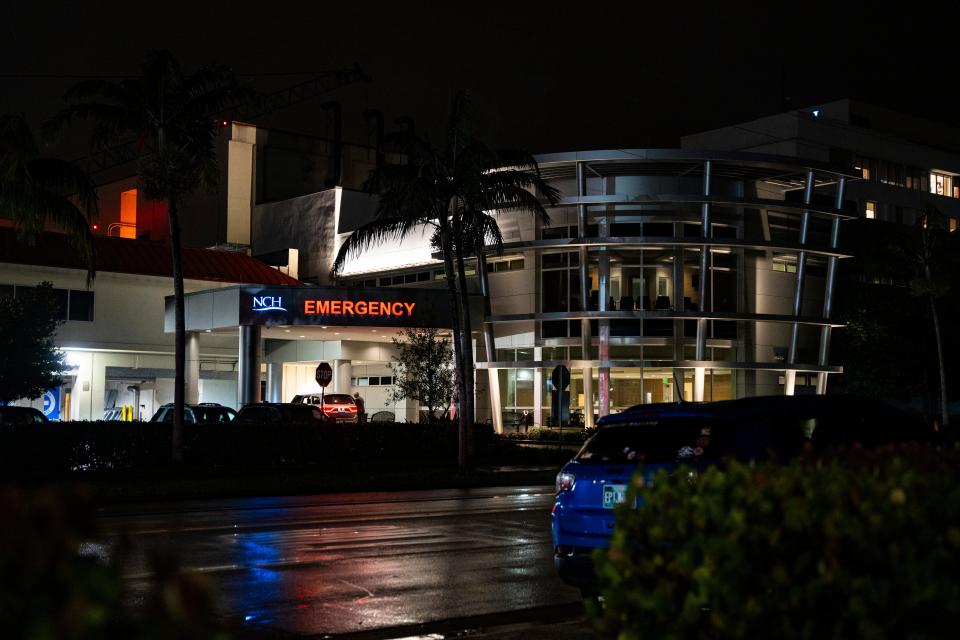
An emergency room physician at the Pine Ridge hospital was attacked last Oct. 20 by a 44-year-old patient, Simon Conde Jr., according to arrest reports.
The patient swung at the doctor, kicked him in the chest, ripped his jacket and spat on him. The patient kicked and spat on other employees while they were restraining him.
The numbers are alarming
The state hospital association, which does not have state data on verbal and physical assaults in hospitals, points to national figures.
Hospital workers are six times more likely to suffer an injury due to intentional violence on the job compared to workers in other fields, according to the U.S. Bureau of Labor Statistics.
The injury rate tied to violence in 2018, the latest year data is available, was 12.8 incidents per 10,000 hospital employees. That’s compared to 2.1 incidents per 10,000 workers in all occupations.
There were 156 homicides of healthcare workers from 2011 to 2018, or roughly 20 a year.
Emergency room physicians don’t hold back on how dangerous their work environment has become and how patient care is being derailed.
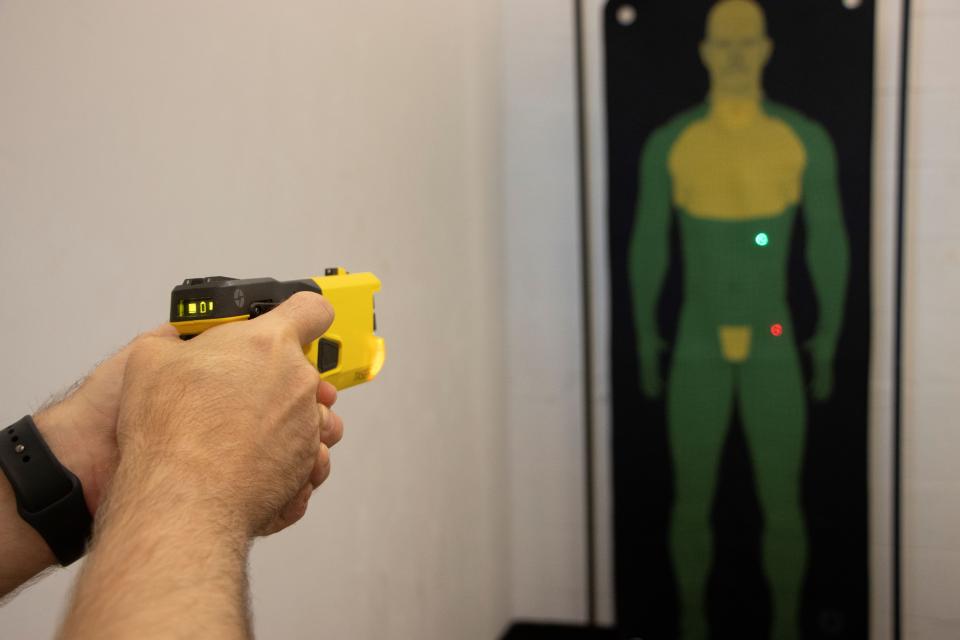
In a September 2022 survey, 85% said assaults have gone up over the last five years; 45% said they have greatly increased, according to the American College of Emergency Physicians.
Nine out of 10 emergency physicians said productivity is impacted, anxiety and emotional trauma among staff is boiling over, and patients are waiting longer for medical attention.
“Violence in emergency departments is too often dismissed as ‘just part of the job,’” Dr. Aisha Terry, president of the emergency physicians group, said in a statement. “This is not just a pandemic problem. Persistent threats and attacks on health care workers put patients at risk and contribute to physician burnout while hindering physician recruitment and retention.”
Two-thirds of the 2,712 doctors surveyed in 2022 said they have been assaulted in the last year while 24% say it happens multiple times a week.
Team Health, the group of emergency physicians under contract with NCH, declined to comment.
Dozens of assaults at Lee Health
The publicly-operated Lee Health in Lee County, which is subject to the state’s public records law, in late 2022 began tracking patient incidents at its five hospitals by different categories of abuse that have since been fine-tuned.
The system has nearly 15,000 employees although many have no contact with patients.
From April through September last year, there were 76 physical assaults and 37 cases of physical aggression, with the latter category now merged with physical assault.
Lee Health documented 53 cases of verbal aggression, 23 verbal assaults with threats of violence and 21 nonviolent verbal threats.
On April 20 last year, a patient at Gulf Coast Medical Center broke out of his vest restraint and was holding an intravenous line pole as a weapon and threatened to strike employees.
He went into the hallway and began charging at employees. Security officers had to use a taser twice before the patient could be subdued.
Last Aug. 1, a male patient at Gulf Coast pulled a female nurse onto his bed while bending her right thumb backwards. Another nurse was able to free the patient’s grip on her colleague.
One shooting occurred where a man went into the emergency room at the Cape Coral hospital on Sept. 2, 2021. He locked himself in a bathroom with a gun and committed suicide.

“There was no threat to staff,” Gloria Graham, system director for public safety and emergency management at Lee Health, said. “We had employees and patients out of harm’s way very quickly.”
What’s going on in emergency rooms?
The emergency room is the catch all for any illness and injury; for people suffering mental health breakdowns; for substance abusers and drug seekers.
The atmosphere is ripe for bad behavior due to anxiety, overcrowding and long wait times.
“It is the activity you are getting in the emergency department, you are getting everything,” Graham said. “It is the (place of) greatest risk for staff.”
Patients with brain injuries or who have been in serious accidents may not be cognizant they are acting out, Elizabeth Gunn, vice president of patient care services at Baptist Medical Center South in Jacksonville, said.
For others the aggression is tied to substance abuse, mental illness, or because they know they won’t face repercussions, she said.
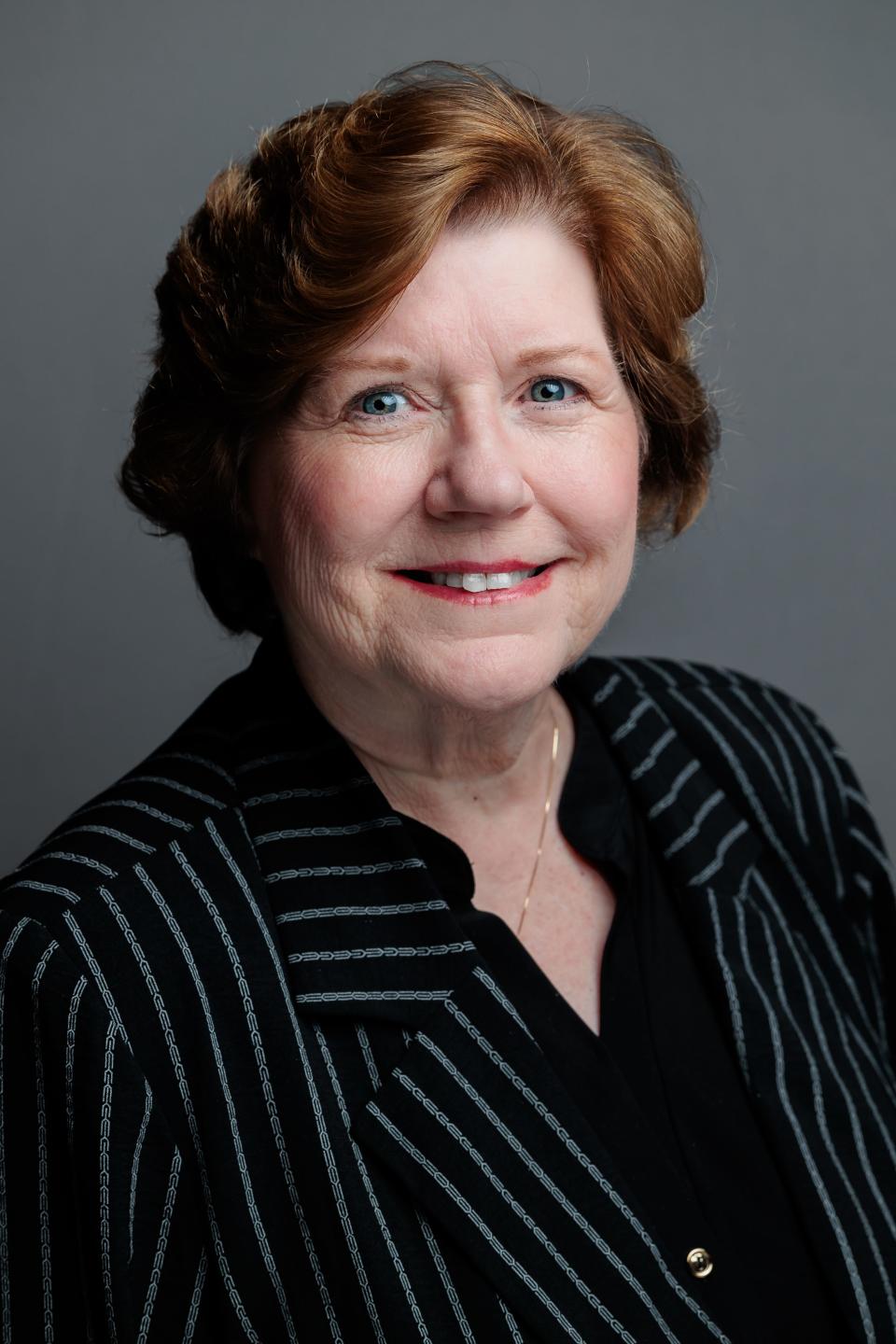
“I’ve had a gun pointed at me. I’ve had people punch me,” Gunn, a former emergency room nurse, said. “Through the years, more patients have become just ugly because they knew there would be no consequences.”
That’s tied to the 1986 federal law that hospitals must treat and stabilize all patients regardless of ability to pay; patients feel they can behave any way they want with impunity, she said.
The emergency room can get quite hectic and ensuring the safety of everyone is a very high priority, said Dr. Richard Macchiaroli, vice president and chief physician executive of Lee Physician Group’s hospital division.
Medications can also lead to altered mental states or personality changes, said Kim Savage, spokeswoman for the publicly-operated Sarasota Memorial Hospital. The risks are well documented, and is why health care workers and public safety teams undergo continuous training to identify the risks, she said.
Attacks got swept under the rug
Patient attacks of hospitals workers, particularly in emergency rooms, historically were under-reported. Some hospitals swept them under the rug.
“A lot of hospitals did not want to rock the boat by bringing charges against a person. Facilities discouraged employees from reporting to law enforcement,” Penny Blake, spokeswoman for the Florida Emergency Nurses Association and past president, said. “Law enforcement and state attorneys’ offices were reluctant to bring charges.”
Police would say they needed verbatim accounts of attacks or they would not write reports, Blake, in Palm Beach County, said.
“The documentation had to show the (perpetrators) knew what they were doing,” Blake said.
She recalls being told getting injured by an out-of-control patient comes with the territory of working in the emergency room.
There’s been a shift away from that attitude in recent years, which she attributes to hospital administrators losing bedside nurses and technicians for safer jobs, worker shortages, and retirement of an aging nurse workforce.
Local hospitals say they don’t deter reporting
Graham, at Lee Health, said some employees don’t want to report aggressive patients even though they are told to step forward.
“They consider it part of the job,” Graham said. “There is a strong encouragement to report. We want to know what the issues are.”
Security officers at Lee Health are notified first when something is happening because they can get to the location quickly. A call to 911 is always an option.
“We absolutely never deter anyone from calling 911,” Graham said, adding that nobody is pressured to hold off calling 911.
“We don’t do that,” Graham said.
In-house security at NCH respond to all incidents of a security nature, Jennifer Smith, system director of emergency management and public safety, said.
“We work very closely with our law enforcement partners to help educate staff on the appropriate use of 911,” Smith said.

Staff are provided guidance on when to call 911 first, Smith said.
“We will absolutely call 911 when necessary,” she said.
Employees at hospitals are trained to detect and respond to out-of-control patients along with alerting in-house security.
Physicians Regional spokeswoman Brittney Thoman said safety and security are a significant area of focus and because the emergency room is a point of entry for many patients the staff prepares for a range of scenarios.
“Our onsite security team of trained officers is here to assist staff with situations where they need extra assistance to de-escalate certain situations,” she said. “This team is prepared to take timely action but staff are also able to call 911 should a life-threatening situation occur.”
All NCH staff must complete workforce violence training annually which includes de-escalation skills, Smith, NCH’s director of public safety, said.
“The goal is for all staff to be able to de-escalate situations to help prevent acts of aggression,” she said.
Impact of COVID-19
The COVID-19 pandemic was an eye opener for hospital leaders to take safety more seriously, experts say.
A 2021 survey of registered nurses at hospitals found 31% said violence during the pandemic increased, according to the emergency nurses association.
Understaffing was an ongoing challenge as bedside nurses and support staff got infected. That led to staffing gaps just as every bed was being used and makeshift intensive care units were opened.
Working in hospitals during the pandemic became untenable for many seasoned nurses who opted for retirement or lucrative travel nurse gigs.
“A lot of nurses were already leaning toward the edge of not wanting to stay and (the pandemic) put them over the edge,” Blake said.
Gunn, of Baptist Medical, said another consequence of COVID-19 was widespread mistrust of medical professionals.
That fueled an attitude if you didn’t like the rules it was OK to break them and be belligerent to hospital staff.
“Everybody believed they were their own expert and people were not wanting to follow the rules,” Gunn said.
Southwest Florida hospital leaders don’t agree patients were more likely to be unruly during the pandemic, even when visitation was halted to help control spread of the virus.
“During this time, NCH continued to manage any acts of aggression as they occurred but there was no direct correlation to the pandemic itself,” Smith said.
Graham, at Lee Health, said it would be hard to say if patients acted out more because of the pandemic.
Sarasota Memorial says incidents of violence have held steady in recent years but tick up in the busier winter with more people coming to the hospital.
So what measures are hospitals taking?
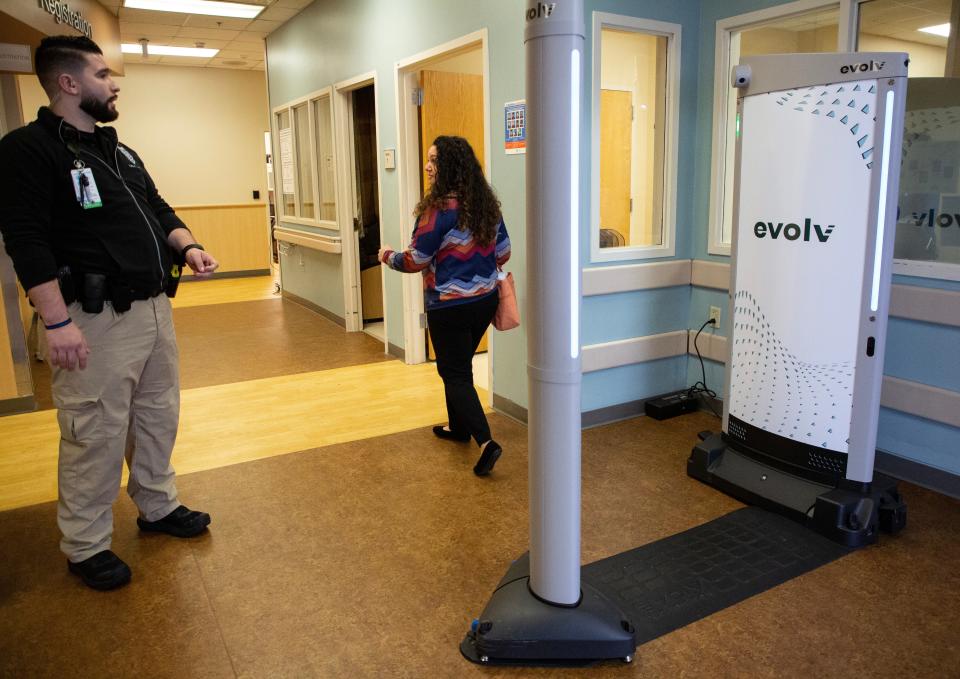
Hospitals are installing metal detectors after many had taken them out because of complaints of an “unfriendly vibe,” Blake said.
All hospitals are evaluating weapons’ detection systems and other technology to beef up security, Mayhew of the state hospital association, said.
“It is a financial investment that will have huge dividends on improving the morale of your staff and sense of safety among your staff,” Mayhew said
NCH is installing metal detectors at its emergency room entrances and security officers wear body cameras. They recently completed training in taser use.
“NCH considers the safety of our patients, visitors and staff as a top priority and, like other healthcare facilities around the nation, are concerned about the rise of incidents against healthcare workers,” NCH spokeswoman Amanda Lucey said.
Physicians Regional declined to comment on specific security measures, yet “multiple complementary security features are in place,” Thoman, the spokeswoman, said.
Lee Health began installing a weapons detection system at emergency rooms last June and it is ongoing. No single event prompted the decision.
“The addition of the weapon detection system to our hospitals has been welcomed by both staff and patients,” Macchiaroli, with Lee physician group, said.
The detectors from Massachusetts-based Evolv use sensors and artificial intelligence to distinguish between a gun and a smart phone. They can detect moderately-sized knives. The system can screen up to 3,600 people an hour.
“What we have seen over time is the technology is much more accepted and more the norm,” Graham, Lee Health’s public safety director, said.
It’s not clear how many hospitals have metal detectors; Evolv systems are used in 250 hospitals nationwide, according to a company official.
What about cameras?
Cameras have been a standard practice in waiting rooms and other common areas; and remote monitoring of patients was critical during the COVID-19 pandemic with staff shortages.
More recently cameras or video surveillance is used to monitor for violence.
Both NCH and Lee Health have cameras in emergency rooms and elsewhere, along with panic buttons that alert security. That's also the case at Sarasota Memorial.
“Our health system and public safety team are equipped with several layers of surveillance, security systems and tools, including tasers, to help monitor and respond to potential threats,” Savage, the spokeswoman, said.
Baptist Health has 125 mobile cameras in half a dozen campus locations for multiple safety reasons, Gunn said.
A centralized team monitors for early signs of aggression, like a milk carton getting thrown at a nurse.
“The cameras are not a secret,” Gunn said. “Each patient knows there is a camera in the room. It is not a recording device. They are not used for criminal proceedings.”
The cameras can be a deterrent against patients acting out.
“Behavior does improve,” she said.
All events are documented that involve patients at risk for falls, for self harm or acting out with staff.
“It has been in the thousands since Jan. 2022,” said Katherine Mitchell, nurse manager in charge of the central monitoring unit.
HCA Florida Healthcare, with 50 hospitals including a freestanding emergency room in Cape Coral, supports efforts by industry leaders to improve safety, HCA spokeswoman Jessica Hopson said in an email.
“As part of our overall safety strategy, we do not publicly discuss the specifics of our security measures, but we have a number of robust policies and procedures in place, including: 24/7 trained security onsite at Fawcett Hospital (in Port Charlotte) and Cape Coral Emergency, live stream cameras, protocols for calling law enforcement and we practice readiness through our participation in local, state and national drills," she said.
What have lawmakers done?
The Florida Legislature last year put more teeth into criminal penalties for knowingly harming emergency room workers and extended the law to all workers throughout hospitals.
Previously only emergency room workers were covered, similar to law enforcement officers and other first responders.
Hospital leaders, like Gunn, and bedside nurses testifed at committee hearings, some sharing chilling personal experiences of being injured on the job.
“This legislation gave another tool in the toolbox and it serves as a deterrent, and it demonstrates to staff their safety is a priority,” Mayhew, with the hospital association, said.
At the federal level, Rubio filed a bill last year that would impose fines and prison time up to 10 years for knowingly assaulting hospital workers or at other medical centers.
Imprisonment would increase to 20 years when a deadly or dangerous weapon is used, according to the draft bill called the Safety from Violence for Healthcare Employees, or SAVE Act. There is companion legislation in the U.S. House.
In a similar move, a bill has been filed that would direct the Occupational Safety and Health Administration to require health care employers to adopt workplace violence prevention plans. The sponsors are Sen. Tammy Baldwin, D-WI, and Rep. Joe Courtney, D-Conn.
There is no national standard in place aimed at preventing and responding to violence in health care settings for employees, said Chris Dellinger, president of the emergency nurses association.
Both bills are supported by dozens of industry groups.
Priscilla Ross, senior director for federal relations with the American Hospital Association, said the measures proposed by Rubio’s bill are needed despite what hospitals have been doing to protect employees.
“The effects of violence against health care workers extend far beyond their physical injuries,” Ross said in a statement. “Workplace violence can disrupt and delay care in hospitals, demoralize staff and make it more difficult to attract and retain workers."
This article originally appeared on Naples Daily News: Hospital violence in SW FL at hands of patients a 'systemic problem'

